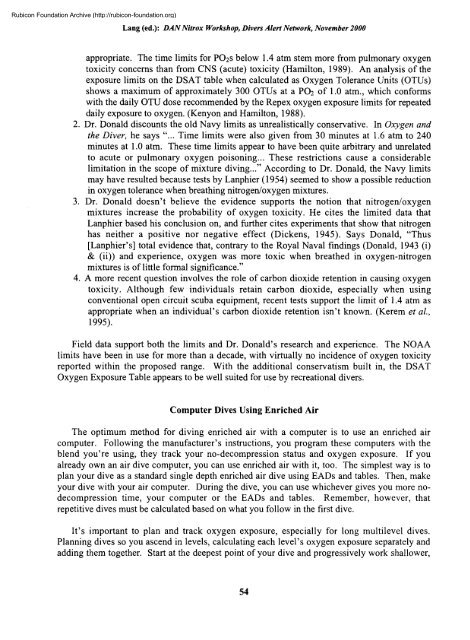Nitrox workshop dings - Divers Alert Network
Nitrox workshop dings - Divers Alert Network
Nitrox workshop dings - Divers Alert Network
You also want an ePaper? Increase the reach of your titles
YUMPU automatically turns print PDFs into web optimized ePapers that Google loves.
Rubicon Foundation Archive (http://rubicon-foundation.org)Lang (ed.): DAN<strong>Nitrox</strong> Workshop, <strong>Divers</strong> <strong>Alert</strong> <strong>Network</strong>, November 2000appropriate. The time limits for PO2S below 1.4 atm stem more from pulmonary oxygentoxicity concerns than from CNS (acute) toxicity (Hamilton, 1989). An analysis of theexposure limits on the DSAT table when calculated as Oxygen Tolerance Units (OTUs)shows a maximum of approximately 300 OTUs at a PO2 of 1.0 atm., which conformswith the daily OTU dose recommended by the Repex oxygen exposure limits for repeateddaily exposure to oxygen. (Kenyon and Hamilton, 1988).2. Dr. Donald discounts the old Navy limits as unrealistically conservative. In Oxygen andthe Diver, he says "... Time limits were also given from 30 minutes at 1.6 atm to 240minutes at 1.0 atm. These time limits appear to have been quite arbitrary and unrelatedto acute or pulmonary oxygen poisoning... These restrictions cause a considerablelimitation in the scope of mixture diving..." According to Dr. Donald, the Navy limitsmay have resulted because tests by Lanphier (1954) seemed to show a possible reductionin oxygen tolerance when breathing nitrogen/oxygen mixtures.3. Dr. Donald doesn't believe the evidence supports the notion that nitrogen/oxygenmixtures increase the probability of oxygen toxicity. He cites the limited data thatLanphier based his conclusion on, and further cites experiments that show that nitrogenhas neither a positive nor negative effect (Dickens, 1945). Says Donald, "Thus[Lanphier's] total evidence that, contrary to the Royal Naval fin<strong>dings</strong> (Donald, 1943 (i)& (ii)) and experience, oxygen was more toxic when breathed in oxygen-nitrogenmixtures is of little formal significance."4. A more recent question involves the role of carbon dioxide retention in causing oxygentoxicity. Although few individuals retain carbon dioxide, especially when usingconventional open circuit scuba equipment, recent tests support the limit of 1.4 atm asappropriate when an individual's carbon dioxide retention isn't known. (Kerem et al,1995).Field data support both the limits and Dr. Donald's research and experience. The NOAAlimits have been in use for more than a decade, with virtually no incidence of oxygen toxicityreported within the proposed range. With the additional conservatism built in, the DSATOxygen Exposure Table appears to be well suited for use by recreational divers.Computer Dives Using Enriched AirThe optimum method for diving enriched air with a computer is to use an enriched aircomputer. Following the manufacturer's instructions, you program these computers with theblend you're using, they track your no-decompression status and oxygen exposure. If youalready own an air dive computer, you can use enriched air with it, too. The simplest way is toplan your dive as a standard single depth enriched air dive using EADs and tables. Then, makeyour dive with your air computer. During the dive, you can use whichever gives you more nodecompressiontime, your computer or the EADs and tables. Remember, however, thatrepetitive dives must be calculated based on what you follow in the first dive.It's important to plan and track oxygen exposure, especially for long multilevel dives.Planning dives so you ascend in levels, calculating each level's oxygen exposure separately andadding them together. Start at the deepest point of your dive and progressively work shallower,54
















